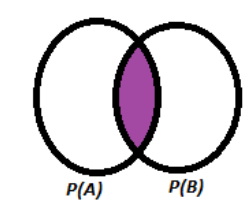
In an examination, one hundred candidates took papers in physics and chemistry. Twenty five candidates failed in physics only. Twenty candidates failed in chemistry only. Fifteen candidates failed in both physics and chemistry. A candidate is selected at random. The probability that he failed either in physics or in chemistry but not in both is
$(a).\dfrac{9}{20}$
$(b).\dfrac{3}{5}$
$(c).\dfrac{2}{5}$
$(d).\dfrac{11}{20}$
Answer
565.5k+ views
Hint:
We can make a Venn diagram from the given. Assume $P(A)$ and $P(B)$are the candidates failed in physics and chemistry only. Then $P(A\cap B)$ denotes the candidates failed in both physics and chemistry. From that we can find $P(A\cup B)$ so that is the probability that the randomly selected candidate failed in either in physics or in chemistry but not in both.
Complete step by step solution:
Assume $P(A)$ are the candidates failed in physics.
Candidates failed in physics only is $25$ so we have to find the $P(A)$ value by adding candidate failed in physics only and candidate failed in both physics and chemistry and divide the value by total number of candidates.
$P(A)=\dfrac{25+15}{100}$
Assume $P(B)$are the candidates failed in chemistry. Candidates failed in chemistry only are $20$.
Same for $P(B)$ we get,
$P(B) =\dfrac{20+15}{100}$
Then $P(A\cap B)$ denotes the candidates failed in both physics and chemistry. Candidates failed in both physics and chemistry are $15$.
Same for $P(A\cap B)$ we get,$P(A\cap B)=\dfrac{15}{100}$

The colored part is the intersection part that is $P(A\cap B)$.
Now we have the formula for union,
$P(A\cup B)=P(A)+P(B)-P(A\cap B)$
In this formula the intersection will be removed by subtracting so we only get the candidate failed either in physics or chemistry. Apply the value we get,
$\Rightarrow P(A\cup B)=\dfrac{25+15}{100}+\dfrac{20+15}{100}-\dfrac{15}{100}$
Adding the numerator value we get,
$\Rightarrow P(A\cap B)=\dfrac{60}{100}$ dividing the value we get,
$\Rightarrow P(A\cap B)=\dfrac{3}{5}$
The probability that he failed either in physics or in chemistry but not in both is $\dfrac{3}{5}$
Note:
The fact that the two circles do not overlap shows that the two events are mutually exclusive. This means that the probability of A and B happening equals the sum of the probability of A and B.
We can make a Venn diagram from the given. Assume $P(A)$ and $P(B)$are the candidates failed in physics and chemistry only. Then $P(A\cap B)$ denotes the candidates failed in both physics and chemistry. From that we can find $P(A\cup B)$ so that is the probability that the randomly selected candidate failed in either in physics or in chemistry but not in both.
Complete step by step solution:
Assume $P(A)$ are the candidates failed in physics.
Candidates failed in physics only is $25$ so we have to find the $P(A)$ value by adding candidate failed in physics only and candidate failed in both physics and chemistry and divide the value by total number of candidates.
$P(A)=\dfrac{25+15}{100}$
Assume $P(B)$are the candidates failed in chemistry. Candidates failed in chemistry only are $20$.
Same for $P(B)$ we get,
$P(B) =\dfrac{20+15}{100}$
Then $P(A\cap B)$ denotes the candidates failed in both physics and chemistry. Candidates failed in both physics and chemistry are $15$.
Same for $P(A\cap B)$ we get,$P(A\cap B)=\dfrac{15}{100}$

The colored part is the intersection part that is $P(A\cap B)$.
Now we have the formula for union,
$P(A\cup B)=P(A)+P(B)-P(A\cap B)$
In this formula the intersection will be removed by subtracting so we only get the candidate failed either in physics or chemistry. Apply the value we get,
$\Rightarrow P(A\cup B)=\dfrac{25+15}{100}+\dfrac{20+15}{100}-\dfrac{15}{100}$
Adding the numerator value we get,
$\Rightarrow P(A\cap B)=\dfrac{60}{100}$ dividing the value we get,
$\Rightarrow P(A\cap B)=\dfrac{3}{5}$
The probability that he failed either in physics or in chemistry but not in both is $\dfrac{3}{5}$
Note:
The fact that the two circles do not overlap shows that the two events are mutually exclusive. This means that the probability of A and B happening equals the sum of the probability of A and B.
Recently Updated Pages
Master Class 12 English: Engaging Questions & Answers for Success

Master Class 12 Economics: Engaging Questions & Answers for Success

Master Class 12 Social Science: Engaging Questions & Answers for Success

Master Class 12 Maths: Engaging Questions & Answers for Success

Master Class 12 Chemistry: Engaging Questions & Answers for Success

Master Class 12 Business Studies: Engaging Questions & Answers for Success

Trending doubts
What are the major means of transport Explain each class 12 social science CBSE

Which are the Top 10 Largest Countries of the World?

Draw a labelled sketch of the human eye class 12 physics CBSE

Explain sex determination in humans with line diag class 12 biology CBSE

The pH of the pancreatic juice is A 64 B 86 C 120 D class 12 biology CBSE

Explain sex determination in humans with the help of class 12 biology CBSE




